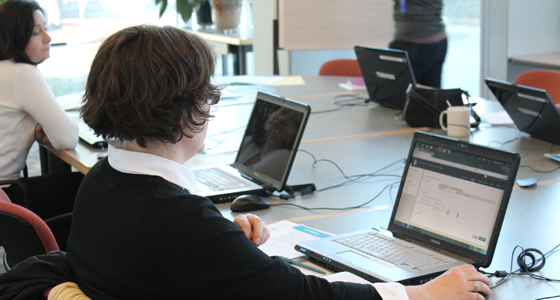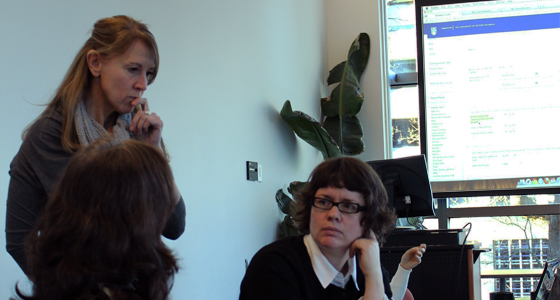 UBC is in the process of moving to a new Learning Management System, Connect. Though it shares many similar features to WebCT Vista, Connect has a number of new features that will benefit both instructors and students. As part of the Connect Institute, the Centre for Teaching, Learning and Technology (CTLT) provides Connect Express workshops that explore the four quadrants of Connect. These workshops explore each individual quadrant: Course Content (which focuses on creating and managing content), Communicate and Collaborate (which explores the different communication and collaboration tools), Assess Student Learning (which focuses on creating and assigning assessments and assignments), and Course Management (which explores some of the course management tools, such as Grade Center). Each quadrant has its own dedicated workshops held throughout the year, as well as workshops encompassing all quadrants for advanced Connect users.
UBC is in the process of moving to a new Learning Management System, Connect. Though it shares many similar features to WebCT Vista, Connect has a number of new features that will benefit both instructors and students. As part of the Connect Institute, the Centre for Teaching, Learning and Technology (CTLT) provides Connect Express workshops that explore the four quadrants of Connect. These workshops explore each individual quadrant: Course Content (which focuses on creating and managing content), Communicate and Collaborate (which explores the different communication and collaboration tools), Assess Student Learning (which focuses on creating and assigning assessments and assignments), and Course Management (which explores some of the course management tools, such as Grade Center). Each quadrant has its own dedicated workshops held throughout the year, as well as workshops encompassing all quadrants for advanced Connect users.
Emily Renoe, CTLT Learning Technology Specialist, facilitated a recent workshop, Connect Express: Delivering Your Course Content. This workshop explored the first quadrant of Connect, Course Content. It is intended for novice and new users of Connect, and focused on creating, organizing, and distributing course materials. Each Connect Express workshop follows a “learn and apply” model. During the first portion of the workshop, attendees learned how to create content areas, upload files, post mash-ups, and create and edit course menus and content. Immediately after the learning portion, attendees applied their new found knowledge onto a sample course in Connect. The content area is the first building block to delivering course content, and attendees were shown how to work with the content area in the course menu of Connect. Three sample content areas were introduced: “Getting Started,” “Week 1,” and “Week 2.” Attendees were then shown how to add material into folders that organize and structure course content within each content area. Materials such as syllabi, lecture notes, course links, and learning modules can be added to each course by the instructor. Each area can be arranged by type of content or, like the sample course used in the workshop, chronologically.
 Workshop attendees were also shown how to bring content into Connect from cloud-based storage services, and how to organize course content with the adaptive release function. Emily demonstrated how to directly upload content from Flickr, Google Drive, and Gmail, into a Connect course. She also noted the use of “mash-ups,” a simple and intuitive way to embed multimedia content, such as YouTube videos, into Connect courses. In addition, Emily showed how it is easier to access and organize course content with Connect. Instructors can drag and drop files to different content areas or folders, and they can control student access to course resources and materials by using the adaptive release function. The adaptive release function allows instructors to make course material visible to students only after certain criteria have been met. Instructors can then point students to important course content before advancing through subsequent course material. For example, instructors can release a course unit only after an assignment has been completed, limit the number of attempts on assignments, and/or make tests available only between specific dates.
Workshop attendees were also shown how to bring content into Connect from cloud-based storage services, and how to organize course content with the adaptive release function. Emily demonstrated how to directly upload content from Flickr, Google Drive, and Gmail, into a Connect course. She also noted the use of “mash-ups,” a simple and intuitive way to embed multimedia content, such as YouTube videos, into Connect courses. In addition, Emily showed how it is easier to access and organize course content with Connect. Instructors can drag and drop files to different content areas or folders, and they can control student access to course resources and materials by using the adaptive release function. The adaptive release function allows instructors to make course material visible to students only after certain criteria have been met. Instructors can then point students to important course content before advancing through subsequent course material. For example, instructors can release a course unit only after an assignment has been completed, limit the number of attempts on assignments, and/or make tests available only between specific dates.
To conclude the workshop, Emily encouraged attendees to attend Connect drop-in clinics for more in-depth support and training. Participants were also encouraged to follow the recommended professional development paths. Please visit the CTLT Events website for more information on upcoming Connect workshops and drop-in clinics.

